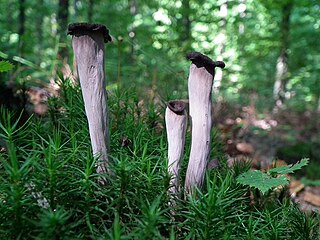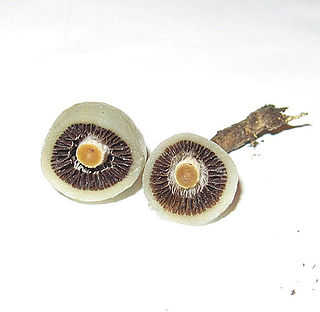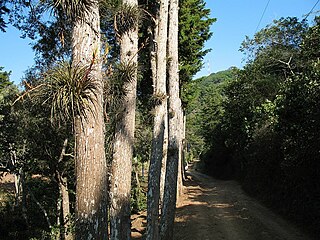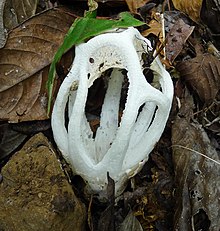
Mycology is the branch of biology concerned with the study of fungi, including their taxonomy, genetics, biochemical properties, and use by humans. Fungi can be a source of tinder, food, traditional medicine, as well as entheogens, poison, and infection.

The Russulales are an order of the Agaricomycetes,. According to the Dictionary of the Fungi, the order consists of 12 families, 80 genera, and 1767 species. According to Species Fungorum, the order contains 13 families, 117 genera, and 3,060 species.

Phallaceae is a family of fungi, commonly known as stinkhorns, within the order Phallales. Stinkhorns have a worldwide distribution, but are especially prevalent in tropical regions. They are known for their foul-smelling, sticky spore masses, or gleba, borne on the end of a stalk called the receptaculum. The characteristic fruiting-body structure, a single, unbranched receptaculum with an externally attached gleba on the upper part, distinguishes the Phallaceae from other families in the Phallales. The spore mass typically smells of carrion or dung, and attracts flies, beetles and other insects to help disperse the spores. Although there is great diversity in body structure shape among the various genera, all species in the Phallaceae begin their development as oval or round structures known as "eggs". The appearance of Phallaceae is often sudden, as gleba can erupt from the underground egg and burst open within an hour. According to a 2008 estimate, the family contains 21 genera and 77 species.

Stemonitis is a distinctive genus of slime moulds found throughout the world. They are characterised by the tall brown sporangia, supported on slender stalks, which grow in clusters on rotting wood. The genus was first described by German botanist Johann Gottlieb Gleditsch in 1753. A 2014 estimate suggests that there are 18 species in the genus. Identification within the genus is difficult, and can only be performed with confidence using a microscope or by DNA sequencing. A fossil specimen is known from the mid-Cretaceous.

Craterellus is a genus of generally edible fungi similar to the closely related chanterelles, with some new species recently moved from the latter to the former. Both groups lack true gills on the underside of their caps, though they often have gill-like wrinkles and ridges.
Index Fungorum is an international project to index all formal names in the fungus kingdom. As of 2015 the project is based at the Royal Botanic Gardens, Kew, one of three partners along with Landcare Research and the Institute of Microbiology, Chinese Academy of Sciences.

Achlya is a genus of oomycete, in the family Saprolegniaceae. The genus includes several plant pathogens including Achlya conspicua and Achlya klebsiana. Unlike many other microorganisms, cell expansion is governed by changes in cell wall strength rather than changes in osmotic pressure. The genome of Achlya hypogyna has been sequenced and can be accessed on public online databases, for example on the NCBI website.

Saprolegniaceae is a family of freshwater mould. James Ellis Humphrey (1861-1897), an American Mycologist did significant work on this family.

Phomopsis is a genus of ascomycete fungi in the family Diaporthaceae. It was previously in the Valsaceae family.

Weraroa was a genus of mushrooms from the families Hymenogastraceae and Strophariaceae. The genus was initially described by mycologist Rolf Singer in 1958 to accommodate the single species Secotium novae-zelandiae reported by Gordon Herriott Cunningham in 1924. It was thought that the genus represented an intermediary evolutionary stage between a hypogeous (underground) ancestor and the related epigeous genus Stropharia. Advances in phylogenetics and taxonomic changes since 1958 found it contained unrelated species from multiple genera. It is now considered a synonym of the genus Psilocybe.

The Stereocaulaceae are a family of lichen-forming fungi in the order Lecanorales. It contains five genera. Species of this family are widely distributed in temperate boreal and austral regions.
The Asterinaceae are a family of fungi in the class Asterinales.

Leucoagaricus is a genus of mushroom-forming fungi in the family Agaricaceae. As of March 2023 there are over 200 accepted species of Leucoagaricus with ongoing research into the genus adding several more each year. Leucocoprinus is a similar genus and considered by some sources to be indistinct from Leucoagaricus based on genetic data that demonstrates they are monophyletic. Species are separated into these genera based on macroscopic features such as cap striations in Leucocoprinus or the more persistent basidiocarps (mushrooms) of Leucoagaricus as well as microscopic features such as the lack of a germ pore in Leucoagaricus species. As a result of the similarities and disagreement on taxonomy, many of the species within these genera have formerly been classified in the other and may still be known by previous classifications. For instance the species Leucoagaricus gongylophorus is cultivated by fungus-growing ants but was formerly known as Leucocoprinus gongylophorus whilst other species cultivated by the lesser attine ants are still classified as undescribed Leucocoprinus species.

Tillandsia rodrigueziana is a species in the genus Tillandsia. This species is native to Mexico, El Salvador, Nicaragua, Guatemala, and Honduras.

Carlo Luigi Spegazzini, in Spanish Carlos Luis Spegazzini, was an Italian-born Argentinian botanist and mycologist.

Saproamanita nauseosa is a species of agaric fungus in the family Amanitaceae. First described by English mycologist Elsie Maud Wakefield in 1918 as a species of Lepiota, it was named for its nauseating odor. The type specimen was found growing on soil in the Nepenthes greenhouse at Kew Gardens. Derek Reid transferred the species to Amanita in 1966, and then in 2016 the separate genus Saproamanita was created by Redhead et al. for saprophytic Amanitas and it was transferred to this new genus.

Amanita ananiceps is a species of agaric fungus in the family Amanitaceae native to Australia.

Baeomyces is a genus of lichenized fungi in the family Baeomycetaceae. Members of Baeomyces are commonly called cap lichens. The genus was circumscribed by German mycologist Christiaan Hendrik Persoon in 1794. Although Persoon did not designate a type species in his original description of the genus, Frederick Clements and Cornelius Lott Shear assigned Baeomyces byssoides as the type in 1931.

Rubroboletus is a genus of bolete fungi in the family Boletaceae. It was circumscribed by Chinese mycologists in 2014 with Rubroboletus sinicus as the type species. Species are characterized by having a reddish cap surface, yellow tubes on the underside of the cap, and an orange-red to blood-red pore surface. Pinkish to red spots (reticula) are present on the stipe surface, and a bluish color change occurs when the bolete flesh is injured. Rubroboletus mushrooms have an olive-brown spore print, and produce smooth spores. Eight species were included in the original circumscription ; five were added in 2015, and another in 2017.

















